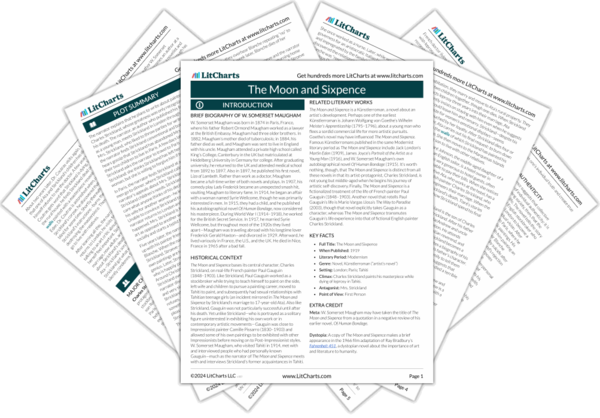In The Moon and Sixpence, beauty in art comes from the truthful expression of the artist’s individual vision. Thus, beauty and individual truth in art are inextricably entwined—and to be a great artist, one must be truthful even if it harms others. This necessity for the artist to be truthful even if it harms others is clearest in the story of Charles Strickland, a conventional English stockbroker who abruptly abandons his wife (Mrs. Strickland) and two children because he wants to become a painter. At first, it isn’t entirely clear why Strickland feels he must abandon his family in order to become a painter; his wife is herself an art enthusiast who claims she would have happily supported Strickland’s change in career. Yet through a series of conversations between Strickland and the novel’s unnamed narrator, it is increasingly implied that Strickland had to abandon his family because his relationships with them were inherently untruthful: he no longer cared about his family members or wanted to cater to their demands on his time and attention, such that staying with them would have been dishonest—and dishonesty is poison to art. The novel, through its unnamed narrator, largely affirms the individual authenticity, honesty, and “greatness” of Strickland’s decision to abandon his family for his painting. As such, The Moon and Sixpence suggests that it may sometimes be worthwhile—or at least understandable—to harm or disregard others in order to express one’s individual truth and create true beauty in art.
Art and Beauty ThemeTracker

Art and Beauty Quotes in The Moon and Sixpence
I do not speak of that greatness which is achieved by the fortunate politician or the successful soldier; that is a quality which belongs to the place he occupies rather than to the man; and a change of circumstances reduces it to very discreet proportions. […] The greatness of Charles Strickland was authentic.
The moral I draw is that the writer should seek his reward in the pleasure of his work and in release from the burden of his thoughts; and, indifferent to aught else, care nothing for praise or censure, failure or success.
It was all false, insincere, shoddy; and yet no one was more honest, sincere, and frank than Dirk Stroeve. Who could resolve the contradiction?
“Beauty is something wonderful and strange that the artist fashions out of the chaos of the world in the torment of his soul. And when he has made it, it is not given to all to know it. To recognize it you must repeat the adventure of the artist.”
“Sometimes I’ve thought of an island lost in a boundless sea, where I could live in some hidden valley, among strange trees, in silence. There I think I could find what I want.”
He did not express himself quite like this. He used gestures instead of adjectives, and he halted. I have put into my own words what I think he wanted to say.
Their life in its own way was an idyll, and it managed to achieve a singular beauty.
Strickland had burst the bonds that hitherto had held him. […] It was not only the bold simplification of the drawing which showed so rich and so singular a personality; it was not only the painting, though the flesh was painted with a passionate sensuality which had in it something miraculous; it was not only the solidity, so that you felt extraordinarily the weight of the body; there was also a spirituality, troubling and new[.]
It may be that in rogues the writer gratifies instincts deep-rooted in him, which the manners and customs of a civilized world have forced back to the mysterious recesses of the subconscious. In giving to the character of his invention flesh and bones he is giving life to that part of himself which finds no other means of expression. His satisfaction is a sense of liberation.
Here lies the unreality of fiction. For in men, as a rule, love is but an episode which takes its place among the other affairs of the day, and the emphasis laid on it in novels gives it an importance which is untrue to life […] As lovers, the difference between men and women is that women can love all day long, but men only at times.
I suppose that art is a manifestation of the sexual instinct […]. It is possible that Strickland hated the normal release of sex because it seemed to him brutal by comparison with the satisfaction of artistic creation.
“But he was blind.”
“Yes; he had been blind for nearly a year.”
“I think Strickland knew it was a masterpiece. He had achieved what he wanted. His life was complete. He had made a world and saw that it was good. Then, in pride and contempt, he destroyed it.”
My Uncle Henry, for twenty-seven years Vicar of Whitstable, was on these occasions in the habit of saying that the devil could always quote scripture to his purpose.













